 First Choice is an R&B/disco music girl group from Philadelphia, Pennsylvania.
First Choice is an R&B/disco music girl group from Philadelphia, Pennsylvania.
During their high school years, singers Rochelle Fleming and Annette Guest were members of a vocal quartet, who performed at public events and talent shows. After they contacted radio DJ Georgie Woods, he introduced them to guitarist, songwriter and producer Norman Harris (who was also the manager of R&B group, The Delfonics).
 By the time the group went into the recording studio, the group’s line-up consisted of Rochelle, Annette, Wardell Piper and Malanie McSears. In 1972, they released their debut single, “This is the House Where Love Died” on the Sceptor Records label; the single failed to make the charts.
By the time the group went into the recording studio, the group’s line-up consisted of Rochelle, Annette, Wardell Piper and Malanie McSears. In 1972, they released their debut single, “This is the House Where Love Died” on the Sceptor Records label; the single failed to make the charts.
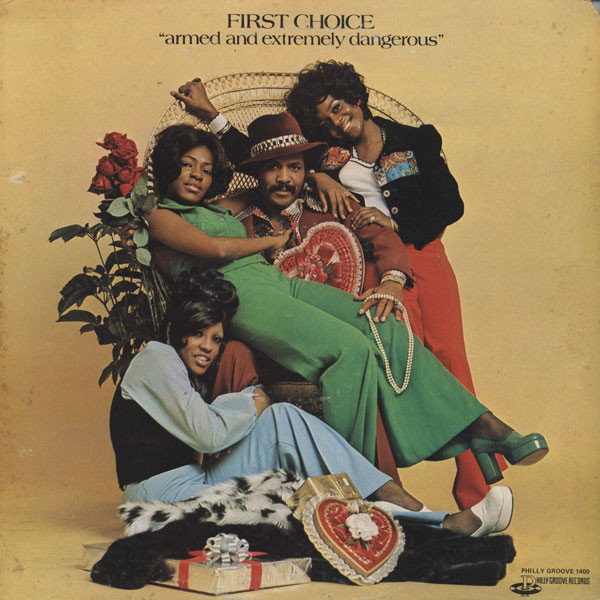 In 1973, First Choice signed a record deal with Philly Groove Records Incorporated. During that same year, they released their debut album, “Armed and Extremely Dangerous” which peaked at #184 on the Billboard 200 and #55 on Billboard’s R&B Albums chart.
In 1973, First Choice signed a record deal with Philly Groove Records Incorporated. During that same year, they released their debut album, “Armed and Extremely Dangerous” which peaked at #184 on the Billboard 200 and #55 on Billboard’s R&B Albums chart.
 The title song became a hit, peaking at #28 on the Billboard Hot 100 and #11 on Billboard’s Hot Soul Singles chart, staying on the chart for 11 weeks. It also peaked at #16 on the U.K. Singles chart and #55 on the music charts in Canada. Around that time, Wardell Piper left the group and was replaced by Joyce Jones.
The title song became a hit, peaking at #28 on the Billboard Hot 100 and #11 on Billboard’s Hot Soul Singles chart, staying on the chart for 11 weeks. It also peaked at #16 on the U.K. Singles chart and #55 on the music charts in Canada. Around that time, Wardell Piper left the group and was replaced by Joyce Jones.
 The follow-up single from the album, “Smarty Pants” peaked at #56 on the Billboard Hot 100 and #25 on Billboard’s Hot Soul Singles chart. It also peaked at #9 on the U.K. Singles chart and was moderately successful in Australia.
The follow-up single from the album, “Smarty Pants” peaked at #56 on the Billboard Hot 100 and #25 on Billboard’s Hot Soul Singles chart. It also peaked at #9 on the U.K. Singles chart and was moderately successful in Australia.
 The last single, “Newsy Neighbors” peaked at #97 on the Billboard Hot 100 and #35 on Billboard’s Hot Soul Singles chart, staying on the chart for 11 weeks.
The last single, “Newsy Neighbors” peaked at #97 on the Billboard Hot 100 and #35 on Billboard’s Hot Soul Singles chart, staying on the chart for 11 weeks.
 In 1974, First Choice released their sophomore album, “The Player” which peaked at #143 on the Billboard 200 and #36 on Billboard’s R&B Albums chart.
In 1974, First Choice released their sophomore album, “The Player” which peaked at #143 on the Billboard 200 and #36 on Billboard’s R&B Albums chart.
 The lead single, “The Player” peaked at #7 on Billboard’s Hot Soul Singles chart, staying on the chart for 13 weeks. It was also moderately successful on the pop charts, peaking at #70 on the Billboard Hot 100.
The lead single, “The Player” peaked at #7 on Billboard’s Hot Soul Singles chart, staying on the chart for 13 weeks. It was also moderately successful on the pop charts, peaking at #70 on the Billboard Hot 100.
 The follow-up single from the album, a cover version of The Pearls’ song, “Guilty” peaked at #19 on Billboard’s Hot Soul Singles chart, staying on the chart for 12 weeks. It failed to make the Billboard Hot 100, but managed to peak at #3 on Billboard’s Bubbling Under Hot 100 Singles chart.
The follow-up single from the album, a cover version of The Pearls’ song, “Guilty” peaked at #19 on Billboard’s Hot Soul Singles chart, staying on the chart for 12 weeks. It failed to make the Billboard Hot 100, but managed to peak at #3 on Billboard’s Bubbling Under Hot 100 Singles chart.
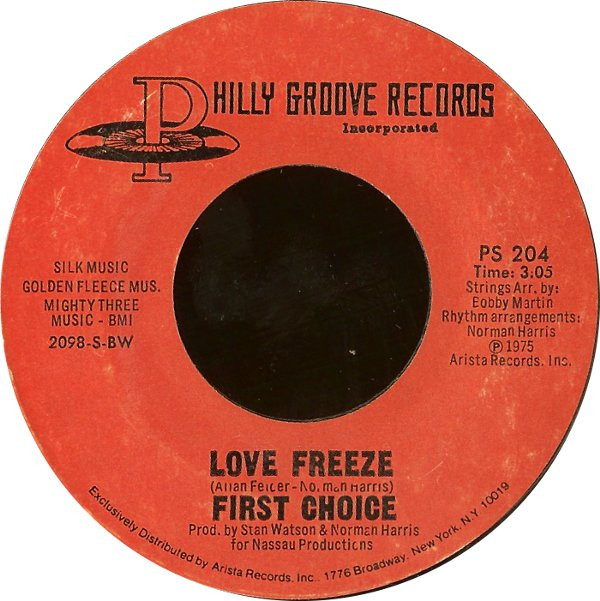 In 1975, First Choice released the single, “Love Freeze” which peaked at #61 on Billboard’s Hot Soul Singles chart, staying on the chart for 7 weeks.
In 1975, First Choice released the single, “Love Freeze” which peaked at #61 on Billboard’s Hot Soul Singles chart, staying on the chart for 7 weeks.
 In 1976, they signed a new record deal with Warner Bros. Records and released their third studio album, “So Let Us Entertain You” which peaked at #53 on Billboard’s R&B Albums chart, but missed the Billboard 200.
In 1976, they signed a new record deal with Warner Bros. Records and released their third studio album, “So Let Us Entertain You” which peaked at #53 on Billboard’s R&B Albums chart, but missed the Billboard 200.
 The first single, “Are You Ready For Me” peaked at #7 on Billboard’s Disco File Top 20 (Record World) chart, staying on the chart for 11 weeks along with the tracks “First Choice Theme” and “Ain’t He Bad.”
The first single, “Are You Ready For Me” peaked at #7 on Billboard’s Disco File Top 20 (Record World) chart, staying on the chart for 11 weeks along with the tracks “First Choice Theme” and “Ain’t He Bad.”
The follow-up single, “Gotta Get Away (From You Baby)” peaked at #16 on Billboard’s Disco File Top 20 (Record World) chart, staying on the chart for 3 weeks. It also peaked at #64 on Billboard’s Hot Soul Singles chart, staying on the chart for 7 weeks.
 The last single released from the album, “Let Him Go” peaked at #96 on Billboard’s Hot Soul Singles chart, staying on the chart for 3 weeks.
The last single released from the album, “Let Him Go” peaked at #96 on Billboard’s Hot Soul Singles chart, staying on the chart for 3 weeks.
 Around 1977, Joyce Jones left First Choice and was replaced by Ursula Herring. During that time, they switched record labels again (signing with the Gold Mind record label) and released their fourth album, “Delusions.” The album peaked at #103 on the Billboard 200.
Around 1977, Joyce Jones left First Choice and was replaced by Ursula Herring. During that time, they switched record labels again (signing with the Gold Mind record label) and released their fourth album, “Delusions.” The album peaked at #103 on the Billboard 200.
 The first single from the album, “Doctor Love” peaked at #8 on Billboard’s National Disco Action Top 40 chart, staying on the chart for 23 weeks. It also peaked at #41 on the Billboard Hot 100 and #23 on Billboard’s Hot Soul Singles chart, staying on the chart for 18 weeks.
The first single from the album, “Doctor Love” peaked at #8 on Billboard’s National Disco Action Top 40 chart, staying on the chart for 23 weeks. It also peaked at #41 on the Billboard Hot 100 and #23 on Billboard’s Hot Soul Singles chart, staying on the chart for 18 weeks.
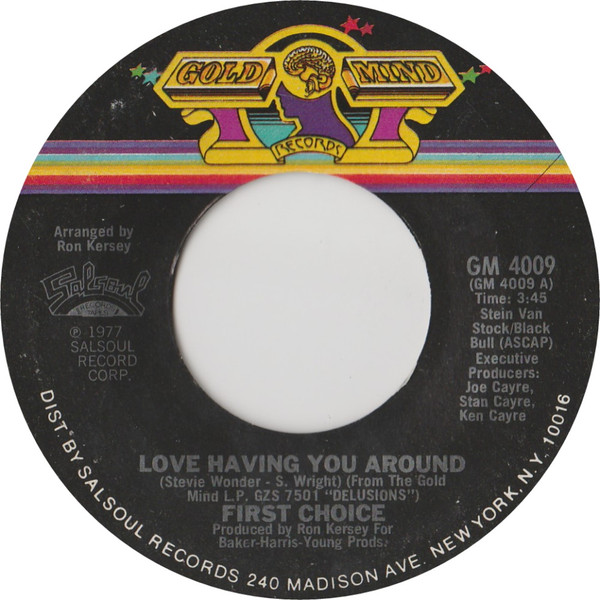 The follow-up and last single, “Love Having You Around” peaked at #68 on Billboard’s Hot Soul Singles chart, staying on the chart for 10 weeks.
The follow-up and last single, “Love Having You Around” peaked at #68 on Billboard’s Hot Soul Singles chart, staying on the chart for 10 weeks.
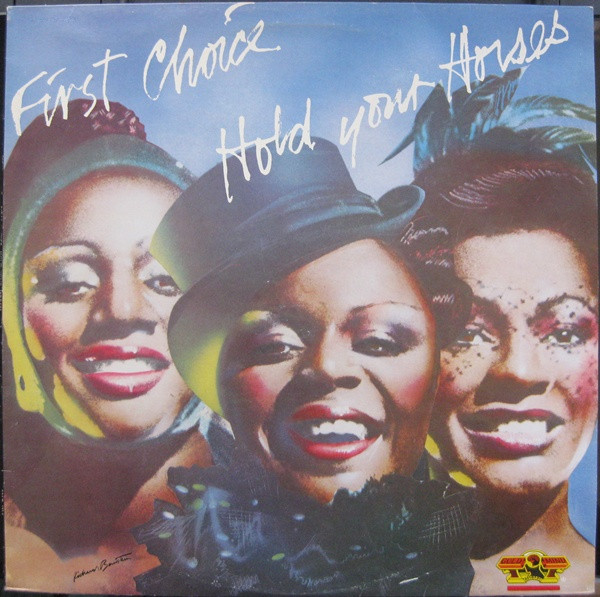 In 1979, First Choice released their fifth studio album, “Hold Your Horses” which peaked at #135 on the Billboard 200 and #58 on Billboard’s R&B Albums chart. During that same year, Ursula Herring left the group and was replaced by Debbie Martin.
In 1979, First Choice released their fifth studio album, “Hold Your Horses” which peaked at #135 on the Billboard 200 and #58 on Billboard’s R&B Albums chart. During that same year, Ursula Herring left the group and was replaced by Debbie Martin.
 The title song peaked at #5 on Billboard’s National Disco Action Top 40 chart, staying on the chart for 32 weeks. It was also moderately successful on the R&B charts, peaking at #73 on Billboard’s Hot Soul Singles chart, staying on the chart for only 5 weeks.
The title song peaked at #5 on Billboard’s National Disco Action Top 40 chart, staying on the chart for 32 weeks. It was also moderately successful on the R&B charts, peaking at #73 on Billboard’s Hot Soul Singles chart, staying on the chart for only 5 weeks.
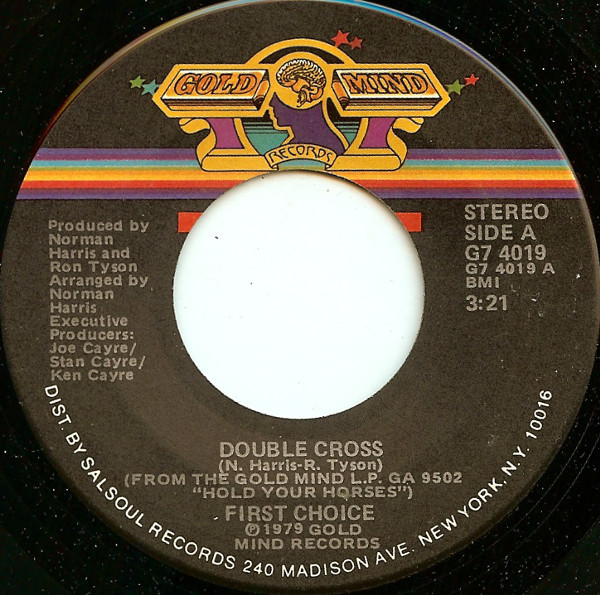 The follow-up single, “Double Cross” peaked at #4 on Billboard’s Bubbling Under Hot 100 Singles chart and #60 on Billboard’s Hot Soul Singles chart, staying on the chart for 5 weeks.
The follow-up single, “Double Cross” peaked at #4 on Billboard’s Bubbling Under Hot 100 Singles chart and #60 on Billboard’s Hot Soul Singles chart, staying on the chart for 5 weeks.
 The last single from the album, “Love Thang” peaked at #52 on Billboard’s Disco Top 80 chart, staying on the chart for 11 weeks.
The last single from the album, “Love Thang” peaked at #52 on Billboard’s Disco Top 80 chart, staying on the chart for 11 weeks.
 In 1980, First Choice released their sixth studio and last album to date, “Breakaway” which didn’t make the album charts at all.
In 1980, First Choice released their sixth studio and last album to date, “Breakaway” which didn’t make the album charts at all.
 The title song peaked at #80 on Billboard’s Disco Top 100 chart, staying on the chart for 5 weeks. During that same year, First Choice disbanded.
The title song peaked at #80 on Billboard’s Disco Top 100 chart, staying on the chart for 5 weeks. During that same year, First Choice disbanded.
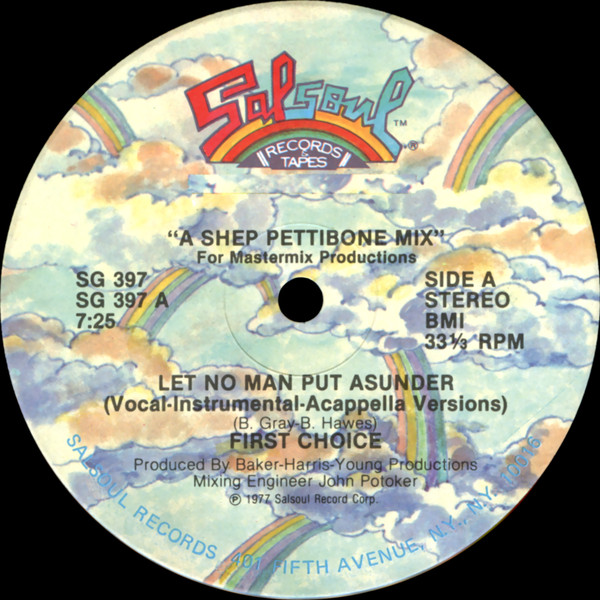 In 1983, Salsoul Records released the group’s song, “Let No Man Put Asunder” (from their “Delusions” album) which peaked at #13 on Billboard’s Dance\Disco Top 80 chart, staying on the chart for 16 weeks. It also peaked at #47 on the music charts in the Netherlands.
In 1983, Salsoul Records released the group’s song, “Let No Man Put Asunder” (from their “Delusions” album) which peaked at #13 on Billboard’s Dance\Disco Top 80 chart, staying on the chart for 16 weeks. It also peaked at #47 on the music charts in the Netherlands.
 In 1984, a remixed version of “Doctor Love” peaked at #61 on Billboard’s Dance Disco\Top 80 chart, staying on the chart for 5 weeks.
In 1984, a remixed version of “Doctor Love” peaked at #61 on Billboard’s Dance Disco\Top 80 chart, staying on the chart for 5 weeks.
 In 1997, the remixes to First Choice’s song, “Armed and Extremely Dangerous” which peaked at #88 on the U.K. Singles chart.
In 1997, the remixes to First Choice’s song, “Armed and Extremely Dangerous” which peaked at #88 on the U.K. Singles chart.
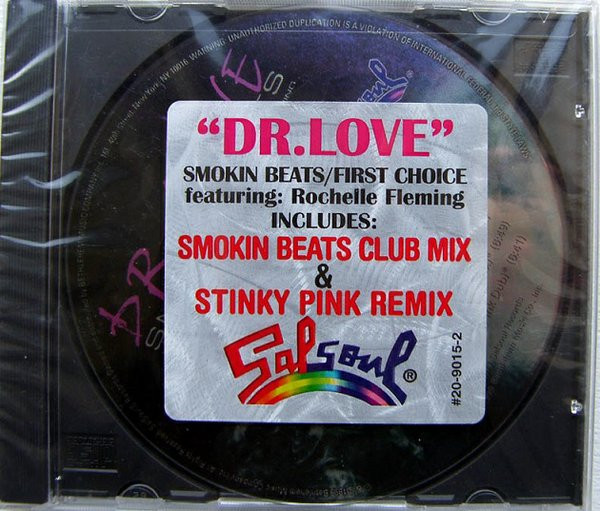 In 1999, the remixes to “Doctor Love” peaked at #22 on Billboard’s Hot Dance Music/Club Play chart, staying on the chart for 9 weeks.
In 1999, the remixes to “Doctor Love” peaked at #22 on Billboard’s Hot Dance Music/Club Play chart, staying on the chart for 9 weeks.
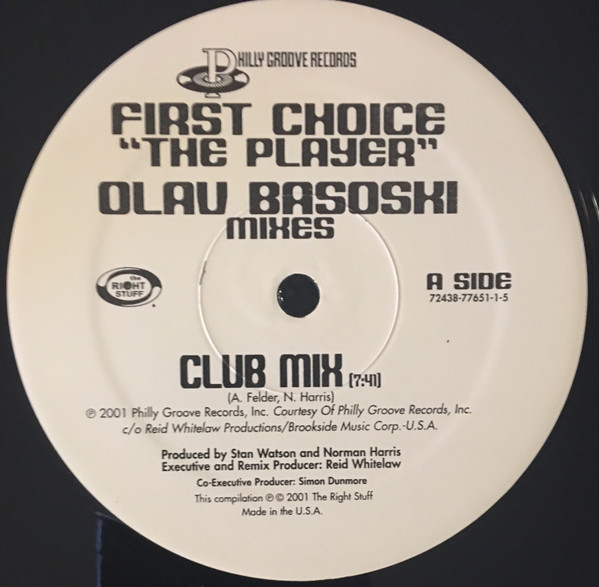 Two years later in 2001, the remixes to “The Player” peaked at #7 on Billboard’s Hot Dance Music/Club Play chart, staying on the chart for 12 weeks.
Two years later in 2001, the remixes to “The Player” peaked at #7 on Billboard’s Hot Dance Music/Club Play chart, staying on the chart for 12 weeks.
 In 2002, the Code Blue record label released remixes to the song, “Ain’t He Bad” which peaked at #89 on the U.K. Singles chart.
In 2002, the Code Blue record label released remixes to the song, “Ain’t He Bad” which peaked at #89 on the U.K. Singles chart.
On August 6, 2014, First Choice performed at the Salsoul Records reunion concert at the East River Park Ampitheatre in New York with Rochelle, Annette, Wardell and Ursula as part of the lineup.
These days (according to research), Rochelle Fleming continues to perform as a solo artist. Annette and Ursula perform as First Choice with member Andre A. Jackson on the Ultimate Disco Cruise.
To follow Rochelle Fleming on Instagram, go to:
https://www.instagram.com/rochelle_fleming/
To see a video for “Armed and Extremely Dangerous”, go to:
To see a video for “Smarty Pants”, go to:
To see a video for “Newsy Neighbors”, go to:
To see a video for “The Player”, go to:
To see a video for “Guilty”, go to:
To see a video for “Love Freeze”, go to:
To see a video for “Are You Ready For Me?”, go to:
To see a video for “First Choice Theme”, go to:
To see a video for “Ain’t He Bad”, go to:
To see a video for “Gotta Get Away (From You Baby)”, go to:
To see a video for “Let Him Go”, go to:
To see a video for “Doctor Love”, go to:
To see a video for “Love Having You Around”, go to:
To see a video for “Hold Your Horses”, go to:
To see a video for “Double Cross”, go to:
To see a video for “Love Thang”, go to:
To see a video for “Breakaway”, go to:
To see a video for “Let No Man Put Asunder”, go to:
To see a video for “This is The House Where Love Died”, go to:

:format(jpeg):mode_rgb():quality(90)/discogs-images/A-64791-1533214671-8319.jpeg.jpg)
:format(jpeg):mode_rgb():quality(90)/discogs-images/R-2743617-1459905950-1656.jpeg.jpg) In 1972, Brass Construction released their debut single, “Two Timin’ Lady” on the Docc record label, owned by producer Jeff Lane.
In 1972, Brass Construction released their debut single, “Two Timin’ Lady” on the Docc record label, owned by producer Jeff Lane.:format(jpeg):mode_rgb():quality(90)/discogs-images/R-10701192-1502753184-3896.jpeg.jpg) In 1975, Brass Construction released their self-titled debut album which peaked at #10 on the Billboard 200 and topped Billboard’s Top R&B Albums chart. It also peaked at #9 on the UK Albums chart. The album was certified Platinum in the United States and Silver in the United Kingdom.
In 1975, Brass Construction released their self-titled debut album which peaked at #10 on the Billboard 200 and topped Billboard’s Top R&B Albums chart. It also peaked at #9 on the UK Albums chart. The album was certified Platinum in the United States and Silver in the United Kingdom.:format(jpeg):mode_rgb():quality(90)/discogs-images/R-871010-1276891639.jpeg.jpg) The lead single from the album, “Changin'” peaked at #24 on Billboard’s Hot Soul Singles chart (staying on the chart for 10 weeks). It was also successful on the dance charts, peaking at #3 on Billboard’s Disco File Top 20 (Record World) chart, staying on the chart for 8 weeks.
The lead single from the album, “Changin'” peaked at #24 on Billboard’s Hot Soul Singles chart (staying on the chart for 10 weeks). It was also successful on the dance charts, peaking at #3 on Billboard’s Disco File Top 20 (Record World) chart, staying on the chart for 8 weeks.:format(jpeg):mode_rgb():quality(90)/discogs-images/R-647647-1284218357.jpeg.jpg) The group gained success with their follow-up single, “Movin'” which topped Billboard’s Disco File Top 20 (Record World) chart for 4 weeks (staying on the chart for 12 weeks) and topped Billboard’s Hot Soul Singles chart for a week, staying on the chart for 18 weeks. It also crossed over to the pop charts where it peaked at #14 on the Billboard Hot 100 and #23 on the UK Singles chart.
The group gained success with their follow-up single, “Movin'” which topped Billboard’s Disco File Top 20 (Record World) chart for 4 weeks (staying on the chart for 12 weeks) and topped Billboard’s Hot Soul Singles chart for a week, staying on the chart for 18 weeks. It also crossed over to the pop charts where it peaked at #14 on the Billboard Hot 100 and #23 on the UK Singles chart.:format(jpeg):mode_rgb():quality(90)/discogs-images/R-799799-1306423125.jpeg.jpg) In October of 1976, the group released their sophomore album, “Brass Construction II” which peaked at #26 on the Billboard 200 and #3 on Billboard’s Top R&B Albums chart. It was certified Gold by the RIAA for sales of 500,000.
In October of 1976, the group released their sophomore album, “Brass Construction II” which peaked at #26 on the Billboard 200 and #3 on Billboard’s Top R&B Albums chart. It was certified Gold by the RIAA for sales of 500,000.:format(jpeg):mode_rgb():quality(90)/discogs-images/R-1275564-1208104893.jpeg.jpg) The lead single from the album, “Ha Cha Cha (Funktion)” peaked at #51 on the Billboard Hot 100, #14 on Billboard’s National Disco Action Top 40 chart (staying on the chart for 9 weeks) and #8 on Billboard’s Hot Soul Singles chart (staying on the chart for 13 weeks). It also peaked at #37 on the U.K. Singles chart.
The lead single from the album, “Ha Cha Cha (Funktion)” peaked at #51 on the Billboard Hot 100, #14 on Billboard’s National Disco Action Top 40 chart (staying on the chart for 9 weeks) and #8 on Billboard’s Hot Soul Singles chart (staying on the chart for 13 weeks). It also peaked at #37 on the U.K. Singles chart.:format(jpeg):mode_rgb():quality(90)/discogs-images/R-3269488-1323627284.jpeg.jpg) The last single released from the album, “What’s On Your Mind (Expressions)” peaked at #69 on Billboard’s Hot Soul Singles chart, staying on the chart for 3 weeks.
The last single released from the album, “What’s On Your Mind (Expressions)” peaked at #69 on Billboard’s Hot Soul Singles chart, staying on the chart for 3 weeks.:format(jpeg):mode_rgb():quality(90)/discogs-images/R-2483839-1479061344-3065.jpeg.jpg) In 1977, Brass Construction released the single, “Celebrate” which peaked at #77 on Billboard’s Hot Soul Singles chart, staying on the chart for 5 weeks. The song fared better on the dance charts (along with the track “We”) which peaked at #37 on Billboard’s National Disco Top 40 chart, staying on the chart for 5 weeks.
In 1977, Brass Construction released the single, “Celebrate” which peaked at #77 on Billboard’s Hot Soul Singles chart, staying on the chart for 5 weeks. The song fared better on the dance charts (along with the track “We”) which peaked at #37 on Billboard’s National Disco Top 40 chart, staying on the chart for 5 weeks.:format(jpeg):mode_rgb():quality(90)/discogs-images/R-435060-1329207887.jpeg.jpg) During that same year, they released their third album, “Brass Construction III” which peaked at #66 on the Billboard 200 and #16 on Billboard’s Top R&B Albums chart. It was also certified Gold by the RIAA.
During that same year, they released their third album, “Brass Construction III” which peaked at #66 on the Billboard 200 and #16 on Billboard’s Top R&B Albums chart. It was also certified Gold by the RIAA.:format(jpeg):mode_rgb():quality(90)/discogs-images/R-1944624-1257159607.jpeg.jpg) The follow-up single from the album, “L-O-V-E-U” peaked at #18 on Billboard’s Hot Soul Singles chart, staying on the chart for 15 weeks; however, it failed to make any impact on the pop charts, but managed to peak at #4 on Billboard’s Bubbling Under Hot 100 Singles chart.
The follow-up single from the album, “L-O-V-E-U” peaked at #18 on Billboard’s Hot Soul Singles chart, staying on the chart for 15 weeks; however, it failed to make any impact on the pop charts, but managed to peak at #4 on Billboard’s Bubbling Under Hot 100 Singles chart.:format(jpeg):mode_rgb():quality(90)/discogs-images/R-491962-1175463051.jpeg.jpg) In 1978, the group released their fourth album, “Brass Construction IV” which peaked at #174 on the Billboard 200 and #24 on Billboard’s Top R&B Albums chart.
In 1978, the group released their fourth album, “Brass Construction IV” which peaked at #174 on the Billboard 200 and #24 on Billboard’s Top R&B Albums chart.:format(jpeg):mode_rgb():quality(90)/discogs-images/R-3182702-1333970992.jpeg.jpg) The two singles released from the album, “Help Yourself” (which peaked at #58) and “Get Up” (which peaked at #56) were moderately successful on Billboard’s Hot Soul Singles chart.
The two singles released from the album, “Help Yourself” (which peaked at #58) and “Get Up” (which peaked at #56) were moderately successful on Billboard’s Hot Soul Singles chart.:format(jpeg):mode_rgb():quality(90)/discogs-images/R-224841-1294192504.jpeg.jpg) In 1979, Brass Construction released their fifth album, “Brass Construction 5” which peaked at #89 on the Billboard 200 and #18 on Billboard’s Top R&B Albums chart. The lead single, “Right Place” peaked at #41 on Billboard’s Hot Soul Singles chart (staying on the chart for 9 weeks) and #74 on Billboard’s Disco Top 100 chart (staying on the chart for 6 weeks).
In 1979, Brass Construction released their fifth album, “Brass Construction 5” which peaked at #89 on the Billboard 200 and #18 on Billboard’s Top R&B Albums chart. The lead single, “Right Place” peaked at #41 on Billboard’s Hot Soul Singles chart (staying on the chart for 9 weeks) and #74 on Billboard’s Disco Top 100 chart (staying on the chart for 6 weeks).:format(jpeg):mode_rgb():quality(90)/discogs-images/R-319718-1255340156.jpeg.jpg) The follow-up single, “Music Makes You Feel Like Dancing” didn’t make the charts in the United States, but managed to peak at #39 on the UK Singles chart.
The follow-up single, “Music Makes You Feel Like Dancing” didn’t make the charts in the United States, but managed to peak at #39 on the UK Singles chart.:format(jpeg):mode_rgb():quality(90)/discogs-images/R-793993-1542840647-2406.jpeg.jpg) In 1980, they released their sixth album, “Brass Construction 6” which peaked at #114 on the Billboard 200 and #21 on Billboard’s Top R&B Albums chart.
In 1980, they released their sixth album, “Brass Construction 6” which peaked at #114 on the Billboard 200 and #21 on Billboard’s Top R&B Albums chart.:format(jpeg):mode_rgb():quality(90)/discogs-images/R-1423161-1573224103-3718.jpeg.jpg) The only song to chart from the album, “How Do You Do (What You Do to Me)” peaked at #71 on Billboard’s Hot Soul Singles chart, staying on the chart for 9 weeks.
The only song to chart from the album, “How Do You Do (What You Do to Me)” peaked at #71 on Billboard’s Hot Soul Singles chart, staying on the chart for 9 weeks.:format(jpeg):mode_rgb():quality(90)/discogs-images/R-1421108-1261686933.jpeg.jpg) In 1982, Brass Construction released their seventh album, “Attitudes” which peaked at #176 on the Billboard 200 and #29 on Billboard’s Top R&B Albums chart.
In 1982, Brass Construction released their seventh album, “Attitudes” which peaked at #176 on the Billboard 200 and #29 on Billboard’s Top R&B Albums chart.:format(jpeg):mode_rgb():quality(90)/discogs-images/R-1014747-1255036454.jpeg.jpg) The lead single, “Can You See the Light” peaked at #23 on Billboard’s Black Singles chart (staying on the chart for 17 weeks) and #64 on Billboard’s Dance\Disco Top 80 chart (staying on the chart for only 7 weeks).
The lead single, “Can You See the Light” peaked at #23 on Billboard’s Black Singles chart (staying on the chart for 17 weeks) and #64 on Billboard’s Dance\Disco Top 80 chart (staying on the chart for only 7 weeks).:format(jpeg):mode_rgb():quality(90)/discogs-images/R-1135961-1378365585-1464.jpeg.jpg) In 1983, the group released their eighth album, “Conversations” which peaked at #31 on Billboard’s Top R&B Albums chart, but missed the Billboard 200 chart.
In 1983, the group released their eighth album, “Conversations” which peaked at #31 on Billboard’s Top R&B Albums chart, but missed the Billboard 200 chart.:format(jpeg):mode_rgb():quality(90)/discogs-images/R-245880-1462627341-3489.jpeg.jpg) The lead single from the album, “Walkin’ the Line” peaked at #17 on Billboard’s Dance\Disco Top 80 chart (staying on the chart for 15 weeks) and #28 on Billboard’s Black Singles chart (staying on the chart for 14 weeks). It was also moderately successful in the United Kingdom, peaking at #47 on the U.K. Singles chart.
The lead single from the album, “Walkin’ the Line” peaked at #17 on Billboard’s Dance\Disco Top 80 chart (staying on the chart for 15 weeks) and #28 on Billboard’s Black Singles chart (staying on the chart for 14 weeks). It was also moderately successful in the United Kingdom, peaking at #47 on the U.K. Singles chart.:format(jpeg):mode_rgb():quality(90)/discogs-images/R-1616907-1542840713-2263.jpeg.jpg) In 1984, they released their ninth album, “Renegades” which peaked at #31 on Billboard’s Top R&B Albums chart and #94 on the U.K. Albums chart.
In 1984, they released their ninth album, “Renegades” which peaked at #31 on Billboard’s Top R&B Albums chart and #94 on the U.K. Albums chart.:format(jpeg):mode_rgb():quality(90)/discogs-images/R-873298-1292913193.jpeg.jpg) The first single from the album, “Never Had a Girl” peaked at #38 on Billboard’s Black Singles chart, staying on the chart for 11 weeks.
The first single from the album, “Never Had a Girl” peaked at #38 on Billboard’s Black Singles chart, staying on the chart for 11 weeks.:format(jpeg):mode_rgb():quality(90)/discogs-images/R-1778604-1248268284.jpeg.jpg) The second single, “Partyline” peaked at #56 on the U.K. Singles chart and #53 on Billboard’s Black Singles chart, staying on the chart for 9 weeks. The last single released from the album, “International” peaked at #70 on the U.K. Singles chart.
The second single, “Partyline” peaked at #56 on the U.K. Singles chart and #53 on Billboard’s Black Singles chart, staying on the chart for 9 weeks. The last single released from the album, “International” peaked at #70 on the U.K. Singles chart.:format(jpeg):mode_rgb():quality(90)/discogs-images/R-317561-1507494938-9228.jpeg.jpg) In 1985, Brass Construction released their tenth and last studio album to date, “Conquest” which failed to make the charts at all.
In 1985, Brass Construction released their tenth and last studio album to date, “Conquest” which failed to make the charts at all.:format(jpeg):mode_rgb():quality(90)/discogs-images/R-1108885-1295314804.jpeg.jpg) The only single to chart from the album, “Give and Take” peaked at #62 on the U.K. Singles chart, #28 on Billboard’s Hot Dance\Disco Club Play chart (staying on the chart for 5 weeks) and #76 on Billboard’s Hot Black Singles chart (staying on the chart for 6 weeks). Throughout the 80s, Randy Muller continued to write, produce and arrange music for other artists, including R&B group Skyy.
The only single to chart from the album, “Give and Take” peaked at #62 on the U.K. Singles chart, #28 on Billboard’s Hot Dance\Disco Club Play chart (staying on the chart for 5 weeks) and #76 on Billboard’s Hot Black Singles chart (staying on the chart for 6 weeks). Throughout the 80s, Randy Muller continued to write, produce and arrange music for other artists, including R&B group Skyy.:format(jpeg):mode_rgb():quality(90)/discogs-images/R-250804-1170480054.jpeg.jpg) In 1988, a new version of Brass Construction’s song, “Movin'” (titled “Movin’ 1988”) peaked at #24 on the U.K. Singles chart and #50 on Billboard’s Hot Dance\Club Play chart, staying on the chart for only a week.
In 1988, a new version of Brass Construction’s song, “Movin'” (titled “Movin’ 1988”) peaked at #24 on the U.K. Singles chart and #50 on Billboard’s Hot Dance\Club Play chart, staying on the chart for only a week.:format(jpeg):mode_rgb():quality(90)/discogs-images/R-169910-1470489148-6764.jpeg.jpg) During that same year, a re-released version of “Ha Cha Cha” peaked at #94 on the U.K. Singles chart. After that, Brass Construction went their separate ways. On November 28, 2005, they reunited for a concert in Paris, France at the Bataclan Arena.
During that same year, a re-released version of “Ha Cha Cha” peaked at #94 on the U.K. Singles chart. After that, Brass Construction went their separate ways. On November 28, 2005, they reunited for a concert in Paris, France at the Bataclan Arena.:format(jpeg):mode_rgb():quality(90)/discogs-images/R-14528712-1589108046-3182.jpeg.jpg) These days (according to research), Randy Muller continues to remain active with his music career. In 2019, he released his third solo album, “Welcome to My Life” on the Wavehill Records label.
These days (according to research), Randy Muller continues to remain active with his music career. In 2019, he released his third solo album, “Welcome to My Life” on the Wavehill Records label.






















:format(jpeg):mode_rgb():quality(90)/discogs-images/A-79103-1356519822-6584.jpeg.jpg)
:format(jpeg):mode_rgb():quality(90)/discogs-images/R-397887-1383900091-7880.jpeg.jpg)
:format(jpeg):mode_rgb():quality(90)/discogs-images/R-701784-1221298941.jpeg.jpg)
:format(jpeg):mode_rgb():quality(90)/discogs-images/R-5972886-1531847405-8390.jpeg.jpg)
:format(jpeg):mode_rgb():quality(90)/discogs-images/R-507285-1279723157.jpeg.jpg)
:format(jpeg):mode_rgb():quality(90)/discogs-images/R-898193-1548376386-1607.jpeg.jpg)
:format(jpeg):mode_rgb():quality(90)/discogs-images/R-4936604-1590529276-7623.jpeg.jpg)
:format(jpeg):mode_rgb():quality(90)/discogs-images/R-507286-1279723388.jpeg.jpg)
:format(jpeg):mode_rgb():quality(90)/discogs-images/R-732768-1500567225-8142.jpeg.jpg)
:format(jpeg):mode_rgb():quality(90)/discogs-images/R-531302-1239275173.jpeg.jpg)
:format(jpeg):mode_rgb():quality(90)/discogs-images/R-1027956-1281049841.jpeg.jpg)
:format(jpeg):mode_rgb():quality(90)/discogs-images/R-534046-1271016732.jpeg.jpg)
:format(jpeg):mode_rgb():quality(90)/discogs-images/R-1749311-1590359008-4198.jpeg.jpg)
:format(jpeg):mode_rgb():quality(90)/discogs-images/R-557222-1423420706-6635.jpeg.jpg)
:format(jpeg):mode_rgb():quality(90)/discogs-images/R-1069819-1414027507-5442.jpeg.jpg)
:format(jpeg):mode_rgb():quality(90)/discogs-images/R-1723252-1239283719.jpeg.jpg)
:format(jpeg):mode_rgb():quality(90)/discogs-images/R-1688330-1274901792.jpeg.jpg)
:format(jpeg):mode_rgb():quality(90)/discogs-images/R-11267013-1513050028-2845.jpeg.jpg)
:format(jpeg):mode_rgb():quality(90)/discogs-images/R-485803-1312619805.jpeg.jpg)

:format(jpeg):mode_rgb():quality(90)/discogs-images/R-1374641-1260468353.jpeg.jpg)
:format(jpeg):mode_rgb():quality(90)/discogs-images/R-2193464-1270050022.jpeg.jpg)
:format(jpeg):mode_rgb():quality(90)/discogs-images/R-818549-1439419064-8186.jpeg.jpg)
 Linda Clifford (born on June 14, 1948 in New York City, New York) is an R&B/dance singer who scored hits on the dance and R&B charts during the ’70s and ’80s.
Linda Clifford (born on June 14, 1948 in New York City, New York) is an R&B/dance singer who scored hits on the dance and R&B charts during the ’70s and ’80s. In 1973, she was signed to Paramount Records and released the single, “(It’s Gonna Be) A Long Long Winter” which peaked at #75 on Billboard’s Hot Soul Singles chart, staying on the chart for 6 weeks. By the mid-’70s, she moved to Curtis Mayfield’s record label, Curtom Records.
In 1973, she was signed to Paramount Records and released the single, “(It’s Gonna Be) A Long Long Winter” which peaked at #75 on Billboard’s Hot Soul Singles chart, staying on the chart for 6 weeks. By the mid-’70s, she moved to Curtis Mayfield’s record label, Curtom Records. In 1977, Linda released her debut album, “Linda” which didn’t make any album charts at all.
In 1977, Linda released her debut album, “Linda” which didn’t make any album charts at all. The lead single from the album, “From Now On” peaked at #94 on Billboard’s Hot Soul Singles chart, staying on the chart for 6 weeks. It also peaked at #28 on Billboard’s National Disco Action Top 40 chart (along with the track “You Can Do It”), staying on the chart for 7 weeks.
The lead single from the album, “From Now On” peaked at #94 on Billboard’s Hot Soul Singles chart, staying on the chart for 6 weeks. It also peaked at #28 on Billboard’s National Disco Action Top 40 chart (along with the track “You Can Do It”), staying on the chart for 7 weeks. In 1978, she released her sophomore album, “If My Friends Could See Me Now” peaked at #22 on the Billboard 200 and #9 on Billboard’s R&B Albums chart.
In 1978, she released her sophomore album, “If My Friends Could See Me Now” peaked at #22 on the Billboard 200 and #9 on Billboard’s R&B Albums chart. The first single, “Runaway Love” peaked at #76 on the Billboard Hot 100 and #3 on Billboard’s Hot Soul Singles chart, staying on the chart for 16 weeks. It also topped Billboard’s National Disco Top 40 chart (along with the tracks “If My Friends Could See Me Now” and “Gypsy Lady”), staying on the chart for 24 weeks.
The first single, “Runaway Love” peaked at #76 on the Billboard Hot 100 and #3 on Billboard’s Hot Soul Singles chart, staying on the chart for 16 weeks. It also topped Billboard’s National Disco Top 40 chart (along with the tracks “If My Friends Could See Me Now” and “Gypsy Lady”), staying on the chart for 24 weeks. The follow-up single, “If My Friends Could See Me Now” (from the musical “Sweet Charity”) peaked at #54 on the Billboard Hot 100 and #68 on Billboard’s Hot Soul Singles chart, staying on the chart for 7 weeks.
The follow-up single, “If My Friends Could See Me Now” (from the musical “Sweet Charity”) peaked at #54 on the Billboard Hot 100 and #68 on Billboard’s Hot Soul Singles chart, staying on the chart for 7 weeks. In 1979, Linda released her third album, “Let Me Be Your Woman” which peaked at #26 on the Billboard 200 and #19 on Billboard’s R&B Albums chart.
In 1979, Linda released her third album, “Let Me Be Your Woman” which peaked at #26 on the Billboard 200 and #19 on Billboard’s R&B Albums chart. Her cover version of Simon & Garfunkel’s song, “Bridge over Troubled Water” peaked at #41 on the Billboard Hot 100 and #49 on Billboard’s Hot Soul Singles chart, staying on the chart for 6 weeks. It also peaked at #11 on Billboard’s National Disco Top 40 chart (along with the tracks “Don’t Give It Up” and “Let Me Be Your Woman”), staying on the chart for 12 weeks.
Her cover version of Simon & Garfunkel’s song, “Bridge over Troubled Water” peaked at #41 on the Billboard Hot 100 and #49 on Billboard’s Hot Soul Singles chart, staying on the chart for 6 weeks. It also peaked at #11 on Billboard’s National Disco Top 40 chart (along with the tracks “Don’t Give It Up” and “Let Me Be Your Woman”), staying on the chart for 12 weeks. In 1979, Linda released her fourth album, “Here’s My Love” which peaked at #117 on the Billboard 200 and #47 on Billboard’s R&B Albums chart.
In 1979, Linda released her fourth album, “Here’s My Love” which peaked at #117 on the Billboard 200 and #47 on Billboard’s R&B Albums chart. The lead single, “I Just Wanna Wanna” peaked at #36 on Billboard’s Hot Soul Singles chart, staying on the chart for 11 weeks. It also peaked at #73 on Billboard’s Disco Top 100 chart (along with the other tracks from the album), staying on the chart for 4 weeks.
The lead single, “I Just Wanna Wanna” peaked at #36 on Billboard’s Hot Soul Singles chart, staying on the chart for 11 weeks. It also peaked at #73 on Billboard’s Disco Top 100 chart (along with the other tracks from the album), staying on the chart for 4 weeks. In 1980, Linda and Curtis Mayfield released a duet album, “The Right Combination” which peaked at #180 on the Billboard 200 and #53 on Billboard’s R&B Albums chart.
In 1980, Linda and Curtis Mayfield released a duet album, “The Right Combination” which peaked at #180 on the Billboard 200 and #53 on Billboard’s R&B Albums chart. The first single released from the album, “Between You Baby and Me” peaked at #14 on Billboard’s Hot Soul Singles chart, staying on the chart for 18 weeks.
The first single released from the album, “Between You Baby and Me” peaked at #14 on Billboard’s Hot Soul Singles chart, staying on the chart for 18 weeks. During that same year, Linda released her sixth studio album, “I’m Yours” which peaked at #160 on the Billboard 200 and #47 on Billboard’s R&B Albums chart.
During that same year, Linda released her sixth studio album, “I’m Yours” which peaked at #160 on the Billboard 200 and #47 on Billboard’s R&B Albums chart. The first single, “Red Light” (which was featured in the 1980 film, “Fame”) peaked at #41 on the Billboard Hot 100 and #40 on Billboard’s Hot Soul Singles chart, staying on the chart for 9 weeks.
The first single, “Red Light” (which was featured in the 1980 film, “Fame”) peaked at #41 on the Billboard Hot 100 and #40 on Billboard’s Hot Soul Singles chart, staying on the chart for 9 weeks. The second single, “Shoot Your Best Shot” peaked at #43 on Billboard’s Hot Soul Singles chart, staying on the chart for 8 weeks. It also topped Billboard’s Disco Top 100 chart for 4 weeks (along with the track “It Don’t Hurt No More”), staying on the chart for 9 weeks.
The second single, “Shoot Your Best Shot” peaked at #43 on Billboard’s Hot Soul Singles chart, staying on the chart for 8 weeks. It also topped Billboard’s Disco Top 100 chart for 4 weeks (along with the track “It Don’t Hurt No More”), staying on the chart for 9 weeks. By 1982, Linda had moved onto Capitol Records and released her seventh album, “I’ll Keep on Loving You” which didn’t make the charts at all.
By 1982, Linda had moved onto Capitol Records and released her seventh album, “I’ll Keep on Loving You” which didn’t make the charts at all. The tracks “Don’t Come Crying to Me” and “Let It Ride” peaked at #1 on Billboard’s Disco Top 80 chart for 3 weeks, staying on the chart for 18 weeks.
The tracks “Don’t Come Crying to Me” and “Let It Ride” peaked at #1 on Billboard’s Disco Top 80 chart for 3 weeks, staying on the chart for 18 weeks.


 In 1985, Linda released her ninth studio album, “My Heart’s On Fire.” The album failed to make the charts and the only track from the album to chart was “The Heat In Me” which peaked at #17 on Billboard’s Hot Dance/Disco Club Play, staying on chart for 7 weeks.
In 1985, Linda released her ninth studio album, “My Heart’s On Fire.” The album failed to make the charts and the only track from the album to chart was “The Heat In Me” which peaked at #17 on Billboard’s Hot Dance/Disco Club Play, staying on chart for 7 weeks. It wasn’t until 1999 that Linda returned to the music charts with the single, “Wanna Give It Up” (with producer Ralphi Rosario) which peaked at #16 on Billboard’s Hot Dance Music/Club Play chart, staying on the chart for 11 weeks.
It wasn’t until 1999 that Linda returned to the music charts with the single, “Wanna Give It Up” (with producer Ralphi Rosario) which peaked at #16 on Billboard’s Hot Dance Music/Club Play chart, staying on the chart for 11 weeks.





 In 2015, Linda collaborated with singers Evelyn “Champagne” King and Martha Wash on the single, “Show Me Love” which peaked at #6 on Billboard’s dance charts.
In 2015, Linda collaborated with singers Evelyn “Champagne” King and Martha Wash on the single, “Show Me Love” which peaked at #6 on Billboard’s dance charts.
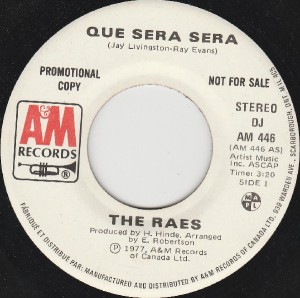 In July of 1977, the Raes scored their first hit song in Canada with a disco-styled cover version of Doris Day’s song, “Que Sera Sera” which peaked at #9 on the RPM Top Singles chart.
In July of 1977, the Raes scored their first hit song in Canada with a disco-styled cover version of Doris Day’s song, “Que Sera Sera” which peaked at #9 on the RPM Top Singles chart. A year later in 1978, the duo released their self-titled debut album on A&M Records; it’s unknown how or if the album made the charts. They were later nominated for two Juno Awards and even hosted their own network variety show called “The Raes” which aired on the CBC network from 1978 to 1980.
A year later in 1978, the duo released their self-titled debut album on A&M Records; it’s unknown how or if the album made the charts. They were later nominated for two Juno Awards and even hosted their own network variety show called “The Raes” which aired on the CBC network from 1978 to 1980. In 1979, the Raes released their sophomore album, “Dancing Up a Storm” which peaked at #161 on the Billboard 200; it’s unknown how the album charted in Canada. They toured the United States to promote the album, making appearances on American TV shows such as “American Bandstand” and “Soul Train.”
In 1979, the Raes released their sophomore album, “Dancing Up a Storm” which peaked at #161 on the Billboard 200; it’s unknown how the album charted in Canada. They toured the United States to promote the album, making appearances on American TV shows such as “American Bandstand” and “Soul Train.” The lead single from the album, “A Little Lovin’ (Keeps the Doctor Away)” peaked at #13 on the RPM Top Singles chart; in the United States, the song peaked at #5 on Billboard’s National Disco Action Top 40 chart (staying on the chart for 14 weeks).
The lead single from the album, “A Little Lovin’ (Keeps the Doctor Away)” peaked at #13 on the RPM Top Singles chart; in the United States, the song peaked at #5 on Billboard’s National Disco Action Top 40 chart (staying on the chart for 14 weeks). The follow-up single, “I Only Wanna Get Up and Dance” peaked at #12 on the RPM Top Singles chart and #19 on the adult contemporary chart in Canada; it also peaked at #47 on Billboard’s National Disco Action chart (staying on the chart for 9 weeks).
The follow-up single, “I Only Wanna Get Up and Dance” peaked at #12 on the RPM Top Singles chart and #19 on the adult contemporary chart in Canada; it also peaked at #47 on Billboard’s National Disco Action chart (staying on the chart for 9 weeks). In 1980, the duo released their last album, “Two Hearts” which didn’t appear to generate a lot of success. By 1982, the music act and the marriage came to an end.
In 1980, the duo released their last album, “Two Hearts” which didn’t appear to generate a lot of success. By 1982, the music act and the marriage came to an end. Alicia Bridges (born on July 15, 1953 in Charlotte, North Carolina) is a disco/pop music singer from the late ’70s.
Alicia Bridges (born on July 15, 1953 in Charlotte, North Carolina) is a disco/pop music singer from the late ’70s. In 1978, Alicia released “I Love the Nightlife (Disco ‘Round)” as her debut single which became a hit, peaking at #5 on the Billboard Hot 100, making it her highest charting single to date.
In 1978, Alicia released “I Love the Nightlife (Disco ‘Round)” as her debut single which became a hit, peaking at #5 on the Billboard Hot 100, making it her highest charting single to date.

 A year later in 1979, she released her follow-up album, “Play It as It Lays” which failed to make any album charts at all. In 1983, a woman was arrested in Nashville, Tennesse for impersonating Alicia during a country music convention.
A year later in 1979, she released her follow-up album, “Play It as It Lays” which failed to make any album charts at all. In 1983, a woman was arrested in Nashville, Tennesse for impersonating Alicia during a country music convention.

 In 1994, “I Love the Nightlife” had a revival when it was featured on the soundtrack to the film, “The Adventures of Priscilla, Queen of the Desert.”
In 1994, “I Love the Nightlife” had a revival when it was featured on the soundtrack to the film, “The Adventures of Priscilla, Queen of the Desert.”


 Wild Cherry was a funk rock band music from the 1970s that was formed by lead singer/guitarist Rob Parissi (born Robert Parissi on December 29, 1950 in Mingo Junction, Ohio) in 1970. The band’s name was taken from a box of cough drops.
Wild Cherry was a funk rock band music from the 1970s that was formed by lead singer/guitarist Rob Parissi (born Robert Parissi on December 29, 1950 in Mingo Junction, Ohio) in 1970. The band’s name was taken from a box of cough drops.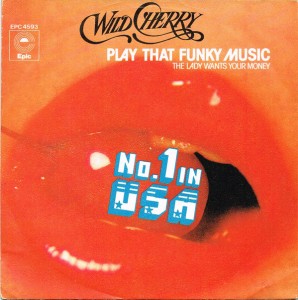 In 1976, “Play That Funky Music” was released as a single and became a hit for Wild Cherry, topping the Billboard Hot 100 & Billboard’s Hot Soul Singles chart. It also peaked at #12 on Billboard’s National Disco Action Top 30 chart (staying on the chart for 12 weeks).
In 1976, “Play That Funky Music” was released as a single and became a hit for Wild Cherry, topping the Billboard Hot 100 & Billboard’s Hot Soul Singles chart. It also peaked at #12 on Billboard’s National Disco Action Top 30 chart (staying on the chart for 12 weeks). In June of 1976, Wild Cherry released their self-titled debut album which peaked at #5 on the Billboard 200, topped Billboard’s R&B Albums chart and was certified Platinum.
In June of 1976, Wild Cherry released their self-titled debut album which peaked at #5 on the Billboard 200, topped Billboard’s R&B Albums chart and was certified Platinum. In April of 1977, the band released their sophomore album, “Electrified Funk” which peaked at #51 on the Billboard 200 and #33 on Billboard’s R&B Albums chart.
In April of 1977, the band released their sophomore album, “Electrified Funk” which peaked at #51 on the Billboard 200 and #33 on Billboard’s R&B Albums chart. The lead single, “Baby Don’t You Know” peaked at #43 on the Billboard Hot 100 and #41 on Billboard’s Hot Soul Singles chart (staying on the chart for 7 weeks).
The lead single, “Baby Don’t You Know” peaked at #43 on the Billboard Hot 100 and #41 on Billboard’s Hot Soul Singles chart (staying on the chart for 7 weeks).

 In 1978, Wild Cherry released their third album, “I Love My Music” which peaked at #84 on the Billboard 200 and #54 on Billboard’s R&B Albums chart.
In 1978, Wild Cherry released their third album, “I Love My Music” which peaked at #84 on the Billboard 200 and #54 on Billboard’s R&B Albums chart. The title song peaked at #69 on the Billboard Hot 100 & #49 on Billboard’s Hot Soul Singles chart (staying on the chart for 8 weeks). Before the band began recording their fourth studio album, Coogie Stoddart left the band again.
The title song peaked at #69 on the Billboard Hot 100 & #49 on Billboard’s Hot Soul Singles chart (staying on the chart for 8 weeks). Before the band began recording their fourth studio album, Coogie Stoddart left the band again. In 1979, they released their fourth and final album, “Only the Wild Survive” which failed to chart at all nor did the single, “Try a Piece of My Love.” It was also the only album to feature rock singer Donnie Iris (who was a member of rock band The Jaggerz) as a performer.
In 1979, they released their fourth and final album, “Only the Wild Survive” which failed to chart at all nor did the single, “Try a Piece of My Love.” It was also the only album to feature rock singer Donnie Iris (who was a member of rock band The Jaggerz) as a performer.